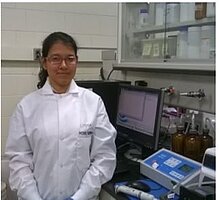Removal of Trichloroethylene and Fluoride from Water by Nanoscale ZeroValent Iron Supported on Novel Activated Carbon

Umma Salma Rashid
Fellow: Umma Salma Rashid
Adviser: Achintya Bezbaruah
Removal of Trichloroethylene and Fluoride from Water by Nanoscale ZeroValent Iron Supported on Novel Activated Carbon
Nanoscale zero-valent iron (NZVI) is an effective reducing agent for removing trichloroethylene (TCE) and an effective adsorptive material for fluoride (F- ) removal from groundwater. However, bare NZVI agglomerates, settles down very quickly and lose their reactivity in aqueous environment. A wood-based activated carbon (AC) was prepared by chemical activation with metal salt to get higher surface area, pore volume and organized pore structure on the surface of AC. NZVI will be supported on the surface of AC by mixing prepared activating carbon with ferrous sulfate heptahydrate followed by chemical reduction with NaBH4. Batch studies will be used to evaluate the TCE and fluoride removal efficiency of NZVI-AC. Adsorption isotherm study will be conducted to determine the equilibrium adsorption capacity and adsorption mechanisms. Additionally, commercial activated carbon was modified with citric acid (CA) to increase fluoride removal efficiency. Fluoride removal studies were conducted with different concentrations of F- . The effect of pH, temperature, natural organic matter (NOM), and other ions were also investigated. Different equilibrium isotherms were used to model the experimental data and Langmuir isotherm was found to fit the data better. Adsorption mechanisms were also investigated using an intraparticle diffusion model. The physicochemical properties of citric acid modified activated carbon (CAAC), bare NZVI and NZVI-AC will be investigated by FTIR, SEM, XPS, and BET analysis. TCE and fluoride removal capacity of CAAC and NZVI-AC will be compared.
Significance of Research
Trichloroethylene (TCE) was a widely used organic solvent for electronic, metal finishing, machinery, and dry-cleaning application. As a result of improper waste disposal practice in the past, TCE has become one of the most problematic classes of volatile organic compounds found in groundwater. Numerous studies have reported that the widespread presence of TCE in groundwater is a serious public health concern due to the hazardous nature of this contaminant. The maximum contaminant level (MCL) for TCE in drinking water is 5 ppb (USEPA, 2011).
Fluoride (F- ) is an anionic constituent found naturally in surface and groundwater. The most common source of fluoride in groundwater is weathering of fluoride bearing mineral such as fluorospar, cryolite and fluroapatite in rocks. In addition to this, mica, amphiboles, certain clays and villiamites also have great effect on the hydrochemistry of fluoride. Drinking water is the major pathway of fluoride to enter in human body. Intake of fluoride within the permissible limit is beneficial for human health in production and maintenance of healthy teeth and bones. On the other hand, prolonged exposure to high Flevels can lead to dental and skeletal fluorosis. Chronic intake of fluoride may also lead to muscle fiber degeneration, low hemoglobin level, excessive thirst, skin rashes, depression, growth retardation, DNA structural changes. The world health organization (WHO) recommends a threshold of 1.5 mg F/L in drinking water, beyond which fluoride can cause detrimental effect. The USEPA has established a MCL of 4 mg/L to prevent against skeletal fluorosis and a secondary MCL of 2 mg/L to protect against dental fluorosis.
NZVI can treat contaminant plumes and the source significantly because of their high surface area to volume ratio, rapid kinetics, and high reactivity. However, bare NZVI agglomerates and settles quickly in aqueous environment, which reduces the available surface area for reduction to occur. Activated carbons (AC) in both granular and powdered forms are the most widely used adsorbents for removing organic pollutants, heavy metals and industrial dyes. Activated carbons are the amorphous form of carbon characterized by high internal porosity and consequently high adsorptivity which are usually related to their specific surface area, pore volume, and porosity. However, AC doesn’t have good fluoride removal capacity. The impregnation of NZVI on AC surface has drawn the attention of researchers in recent years as it can increase the adsorption capacity of AC and at the same time can retain the reactivity of NZVI. Keeping all these in mind, a set of ACs was made by chemical activation with metal salt and metal hydroxides at different ratio to get an organized pore structure, high surface area and high pore volume. Additionally, citric acid can be used to modify the surface of commercial activated carbon by introducing additional carboxyl group onto their surface. Citric acid is biodegradable and widely used in the food and pharmaceutical industries and was selected to modify the surface of commercial activated carbon to increase the fluoride removal efficiency.
Significant Findings
- A set of activated carbon powders (AC) was made by chemical activation with metal salt and metal hydroxides to get an organized pore structure, high surface area and high pore volume. At lower concentration (200 mg/L of methylene blue) all the AC samples showed same amount of removal but at high concentration (500 mg/L of methylene blue) KOH and KCl activated AC showed better removal (99%) than NaOH and NaCl activated AC (66%). The optimum impregnation ratio for KCl to AC is 1:1 and and for NaCl to AC is 1:2.
- Citric acid was used to modify the surface of commercial activated carbon by introducing additional carboxyl group onto their surface.
- Batch studies showed that, with citric acid modified activated carbon (CAAC), Fconcentration decreased from 5 ppm to 1 ppm (80% reduction), 10 ppm to 3 ppm (70% reduction) and 20 ppm to 7 ppm (70% reduction) in first 60 min whereas AC removed only 30%, 25% and 23% for the same initial concentrations and the same reaction time.
- Batch equilibrium study was done to find out the point of zero charge (PZC) of CAAC. The PZC of CAAC was found to be 4.09 which means CAAC will adsorb F- more efficiently at pH below 4.09.
- Adsorption isotherm showed that CAAC has fluoride removal capacity of 1.6 mg/g whereas AC has fluoride removal capacity of 0.8 mg/g. Adsorption data were fitted in Freundlich and Langmuir isotherm models and Langmiur isotherm (R2 = 0.976) was found to be fitted better than Freundlich (R2 = 0.942).
- The removal efficiency of F- was maximum (100%) at low pH (= 2) and removal efficiency decreases with the increase of pH till pH = 5 (70%) and after that efficiency is more or less same (70%).
- Desorption study showed that only 10% of adsorbed F- was desorbed in first 24 hours but after that the amount of desorption is insignificant.
- There is no interference by other environmentally significant ions (SO4 2- , NO3 - , PO4 3- , HCO3 - , Cl- , NOM and humic acid) at low concentration of interfering ions (10 ppm).
- F - removal efficiency is not affected by temperature till 30 oC. However, at high temperature (35, 40 and 45 oC) removal efficiency increased by 3%-5%.
Publications
Rashid, U. S., M. F. Pate, S. Simsek, A. N. Bezbaruah. Coating of NZVI particles with modified starch: Colloidal stability and nitrate reduction studies. Environmental Pollution, in preparation.
Presentations
Rashid, U.S., Simsek, S., Bezbaruah, A.N. Tapioca Starch based Polymer for Surface Modification of Iron Nanoparticles, AEESP Distinguished Lecture Series Poster Session, Minneapolis, Minnesota, March 2017.

Achintya Bezbaruah
Civil & Environmental Eng.
Office: Civil/Ind Eng 201G
Telephone: 701-231-7461
Email: a.bezbaruah@ndsu.edu


